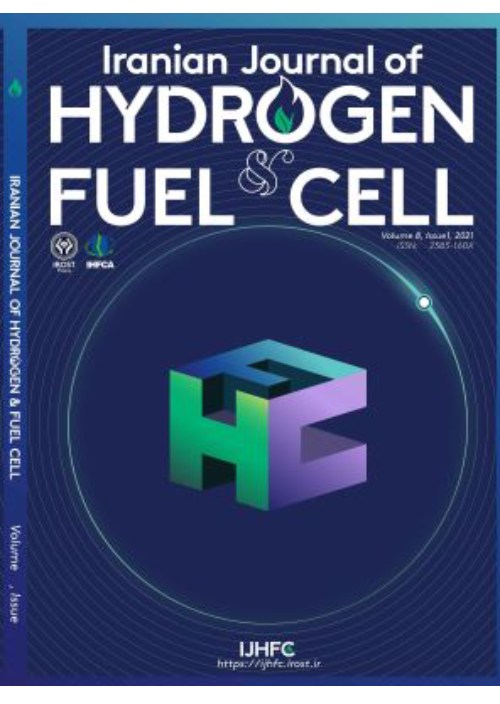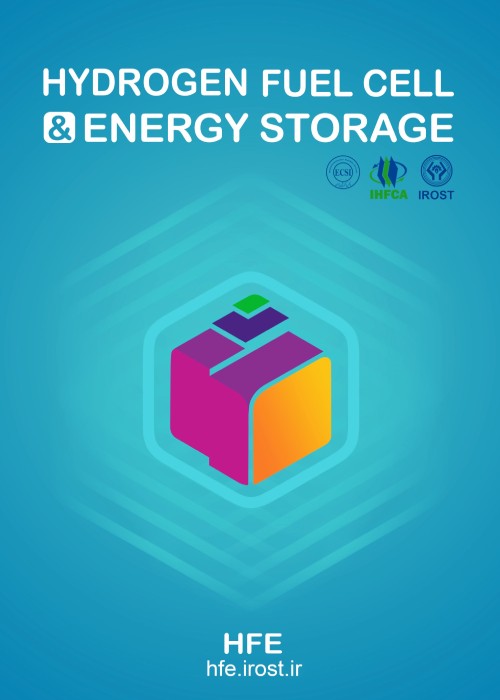فهرست مطالب

Journal of Hydrogen, Fuel Cell and Energy Storage
Volume:9 Issue: 2, Spring 2022
- تاریخ انتشار: 1401/07/09
- تعداد عناوین: 6
-
-
Pages 97-106One of the most important components of a polymer electrolyte membrane fuel cell is the endplate, which must exert uniform contact pressure distribution on the membrane electrode assembly. Since the endplates must be highly rigid, it is essential to consider the flexural modulus parameter when designing these plates. In this study, the production of lighter-weight endplates with a higher flexural modulus is significantly improved by replacing heavy metallic plates with polymer composite plates. The vacuum bag manufacturing technique was used to create these composite plates from epoxy resin, carbon fibers, and glass fibers, making them compatible with the environment of the fuel cell. The flexural modulus and heat deflection temperature of each sample were evaluated before and after a simulated environment test of the fuel cell. Then, the amount of water absorption for each specimen was calculated. Finally, the composite endplates were fabricated using the two different laminations of fibers to find the optimum fiber lamination to maximize the endplate flexural rigidity. The optimum sample contained carbon fibers with an epoxy resin with 0 degrees arrangement. This specimen has a flexural modulus of about 93.17 GPa, heat deflection temperature of about 261 °C, and water absorption of about 0.86%, which are ideal for fuel cell endplates.Keywords: PEM fuel cell, Polymer composite endplate, Flexural modulus, Glass fiber, Carbon fiber
-
Pages 107-116In this study, the fracture method is used to numerically and experimentally investigate the bending load of graphite-based composite bipolar plates of polymer electrolyte membrane fuel cells. First, simple and perforated composite bipolar plates were tested and simulated to determine flexural stability under static load. Then, mechanical simulation using the finite element method and Abaqus software was used for the numerical analysis. Next, an experimental three-point bending test was performed on the manufactured samples to validate the simulation results. Finally, the results of the numerical and experimental analyzes of the flexural behavior of composite bipolar plates were compared. The results demonstrated that the numerical results acceptably agreed with the experimental data. In addition, the presence of a high percentage of graphite and high fragility weakened the body due to the molecular bond of graphite, which caused the graphite to slip.Keywords: PEM fuel cell, Composite Bipolar Plate, Three-Point bending, Finite element simulation
-
Pages 117-132High step-up DC-DC converters are considered as main components of some low-voltage and low-power fuel cell power system applications. A new DC-DC converter topology based on a two-stage switched capacitor-switched inductor multiplier is proposed in this paper. In comparison with other conventional and high step-up DC-DC converters, the proposed converter topology provides higher voltage gain and lower switch voltage stresses for the duty cycles in the range of 0.6 or higher, which is the common duty cycle range of high step-up DC-DC converters. The proposed converter consists of a novel combination of switched capacitors and switched inductors methods which lead to the reduced number of required switches and their duty cycles. The theoretical analysis is confirmed by simulation results in MATLAB/Simulink software environment results. A 100 W laboratory prototype of the proposed converter is implemented to investigate and validate the analytical and simulation results. The prototype DC-DC converter is designed and implemented to be used for a commercial 100 W PEM fuel cell stack power system.Keywords: high step-up, converter, fuel cell
-
Pages 133-147In this study, nickel oxide-gadolinium doped ceria, NiO–GDC, composite powder was synthesized by the sol-gel method with a new Ni(II) complex. New Ni(II) complex with the chemical formula [Ni(μ-L)]n(NO3)2, L = N’-(pyridine-2-yl)methylene)isonicotinohydrazide), have been used as a new precursor. The new Ni(II) complex has been prepared by the reaction between ligand, L, and Ni(NO3).6H2O by hydrothermal method. Then the NiO–GDC powders have been synthesized by Ce(NO3)3.6H2O and Gd(NO3) 3.6H2O and as-synthesized new Ni(II) complex, [Ni(μ-L)]n(NO3)2 by sol-gel method. To increase the performance of solid oxide fuel cells (SOFCs) operating at intermediate temperatures (600–800 ℃), by increasing the three-phase boundary region in the anode, the NiO-GDC powder was modified. The NiO–GDC anode powders as prepared by new precursor has been compared with the NiO-GDC anode powders that has been synthesized from metal nitrates as a precursor. The results showed that the modified NiO-GDC anode has more three-phase boundaries, TPB, a more uniform microstructure, a higher specific surface area, and a porous structure that effectively improved the electrochemical performance of the electrode. The resistance of half-cells of SOFC with this high-performance anode decreased by 85 % at 800 ℃ when compared to conventional half-cells.Keywords: Microstructures, three-phase boundaries, electrochemical performance, Ni(II) complex, SOFC
-
Pages 149-161Nowadays, study on alternative sources of fossil fuels for power generation has attracted great attention. Polymer electrolyte membrane fuel cells (PEMFCs) have higher energy densities and lower power densities than the conventional batteries. PEMFCs should be hybridized with battery to increase the stability without decreasing the maximum power. Typically, DC-DC converters are utilized to combine these systems leading to significant increase in cost, size and weight of system; however, using these converters reduces system efficiency. In this paper, a circuit is implemented for PEMFC and battery hybridization system with a power path controller. The experimental investigations covers the main challenges in the PEM fuel cell power system implementation concerning current ripple and electric power changes dynamics. This circuit implementation leads to increasing system efficiency over 95 percent and decreasing the cost by at least 50 percent. The hybridization circuit is verified by simulation and experimental results.Keywords: PEM Fuel Cell, Lead-Acid Battery, Hybridization Circuit, DC/DC Converter, Switch.Keywords: PEM fuel cell, Lead-Acid Battery, Hybridization Circuit, DC, DC Converter, Switch
-
Pages 163-178Sealants are one of the most important components of the proton exchange membrane fuel cells (PEMFCs). It has significant roles in issues like safety, energy density, durability and performance of the fuel cells. Thus choosing the proper kind of the sealant which is suitable for PEMFCs may cause to develop the performance of the fuel cells. Sealants must be chemically and physically stable in order to have good performance during the defined lifetime for the fuel cell. The durability of the seal means that it has the ability to be placed in the environment of the fuel cell for a long time, and its physical and chemical properties changes should be small, and performs the sealing function correctly. In this paper, mechanical properties of three different types of materials that are frequently used for fuel cell sealing are assessed in an environment similar to the fuel cells ones. These three materials are silicone, EPDM (ethylene propylene dyne monomer) sheet, and molded EPDM. Mechanical properties of the materials are obtained after being used in environment resembling a fuel cell at specific time and temperature. The mechanical and chemical properties of the specimens such as are hardness, weight changes, tensile strengths, compression set and spectrometry are carried out in accelerated durability test of simulated PEMFC environment. These tests are gathered in the period of 100 days. The results revealed that the molded EPDM is the best sealant from others based on the obtained properties in fuel cell working conditions.Keywords: Durability test, mechanical properties, PEM fuel cell, Sealant


